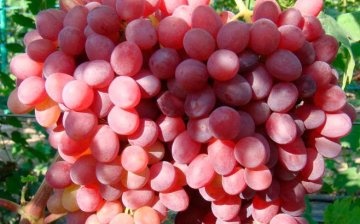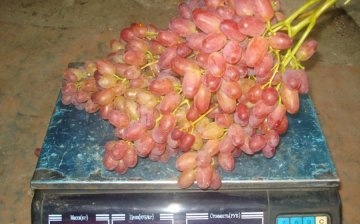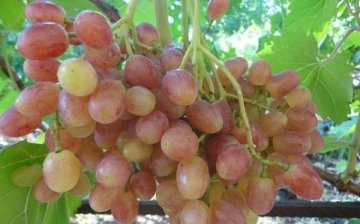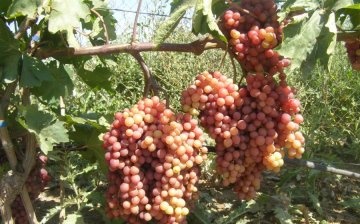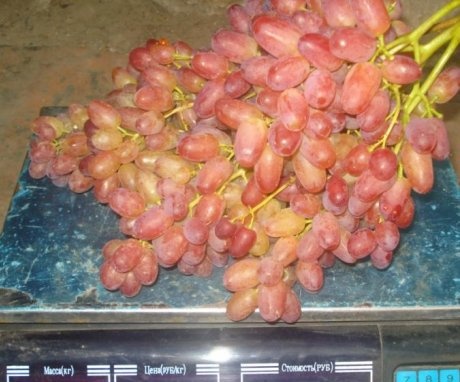Veles grape is an early ripe hybrid variety with large nutmeg berries
Seedless grape varieties, which are popular with gardeners, have been cultivated by humans since ancient times. Breeders are actively and successfully working towards the development of new varieties with underdeveloped and almost imperceptible grape seeds.
Content:
- Seedlessness class of a new variety
- Plant flowers
- Bunches and berries
- Ripening period
- Frost resistance
- Disease resistance
- Growing and care
- Transportability
- Awards
For those who wish to have a productive vineyard on their plot, it makes sense to plant seedless (raisins). One of the new interesting varieties of this culture, named after the ancient Slavic god of fertility, will be discussed below.
Seedlessness class of a new variety
In 2009, in Zaporozhye (Ukraine), the national breeder V.V. Zagorulko, a new seedless form of Veles grapes was bred by crossing the varieties Sofia and Rusbol. That year was distinguished by unusual weather conditions, while the mass of seed rudiments (rudiments) deviated more from the usual one even in seedless varieties of classes 1 and 2. The greater the mass of rudiments, the higher the class of seedlessness of culture.
Therefore, in relation to determining this indicator for a new variety, research is still being carried out - according to some results Veles belongs to the 3rd class, according to others - to the 4th. The study of the characteristics of the variety takes place in the climatic conditions of the south of Belarus.
Plant flowers
The bushes of the Veles grape variety are vigorous, the vine ripens thoroughly, practically for the entire length of the branch. Rooting cuttings happens easily enough. On one vegetative shoot, 2-4 flowers are formed. In this variety, they are bisexual or hermaphrodite, containing both pistils and stamens. Although the flower is well pollinated, additional pollination is carried out in order to increase yields, which contributes to an increase in this indicator up to 20%.
Bunches and berries
The bunches of this grape variety are characterized by large and very large size, medium in looseness, branched. Their weight reaches 3 kg or more. The bunches have a beautiful conical, less often cylindrical shape. The berries of the variety are also large, their weight ranges from 4 to 5 g.
Ripe fruits are very aesthetic, as they have a noble pink color and amber transparency. Light nutmeg aroma, dense pulp and thin skin make the berries very tasty. According to winegrowers, some berries have not only remnants of rudiments, but also soft bones, almost invisible when eaten.
In conditions of high humidity, berries can severely crack and rot. In dry weather, they hang on the bush for a long time - up to 1.5 months, without loss of taste, and do not dry out, do not dry out. The comb of the bunch is very fragile, but the berries are held tight and come off with effort.
Ripening period
This form of grapes ripens very early. The moment of bud opening and full maturity of the variety is separated by an average of 95-100 days. When growing grapes outdoors, the main harvest ripens by the beginning of August. The variety is characterized by education stepsonson which clusters appear. By the beginning of October, they provide the second wave of the harvest - stepchild's.
Frost resistance
The level of frost resistance in the fruit bud of the vine of this hybrid is -21 degrees, which is not lower than similar indicators for other varieties. Nevertheless, Veles is recommended to be grown in conditions of shelter of seedlings and own-rooted bushes, using the film tunnel method in winter. According to the observations of winegrowers, the main eyes of the culture do not freeze under such conditions.
Disease resistance
Currently, Veles' resistance to fungal diseases is under further study. Mildew resistance - false powdery mildew, the main fungal disease of crops grown in open field conditions, is set equal to 3.5 points. The same value of this indicator to another fungal disease - odium, affecting the green organs of grapes.
Growing and care
The variety belongs to the vigorous grape form. To accelerate the ripening process of berries, improve their quality and increase the size of the grape cluster, the grape vine fruiting cut off on average, up to 6-8 eyes, and possibly shorter. The yield is high and stable. Seedlings are sold in rooted or grafted form.
Transportability
Due to the fact that the berries of this variety are characterized by elastic flesh, the grapes perfectly tolerate transportation.
Awards
In 2010, an international competition called "The Golden Bunch of Grapes" was held in Simferopol. The Veles variety received two gold medals awarded by the "People's Tasting Commission" and the "Professional Tasting Commission".
The beautiful color of the bunch gives it a rich presentation, and its pleasant taste, relatively easy care and high yield make the variety very popular among winegrowers. It is used, like all seedless varieties, for fresh, dried consumption, for making juices and wines.



